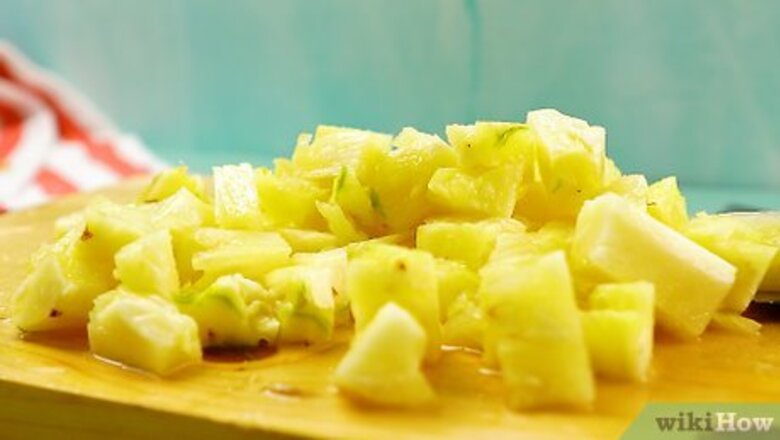
views
- Stick chopped pineapple in the refrigerator for up to 3 days in an airtight container. Store it with a little citrus juice so it doesn’t go brown.
- Freeze pineapple for 8 to 12 months in a freezer-safe bag or container.
- Enjoy canned pineapple within 18 months of preserving it. Once opened, refrigerate the fruit for up to 1 week.
How to Store Cut Pineapple

Refrigerate cut pineapple for 3 days in an airtight container. Uncut pineapples don’t need to be refrigerated, but cut-up pineapples definitely do. Transfer the chopped-up slices to an airtight container and eat them within 3 days to enjoy them at their freshest. To keep the chunks from going brown, cover them in a tiny bit of orange, lemon, or lime juice. What about whole pineapple? Whole, ripe pineapple lasts for 3 days on your countertop. Confirm that the fruit is ripe by smelling for a tropical/fruity scent, successfully pulling off one of the leaves/fronds, and checking if the fruit “gives” a tiny bit when you press on it.
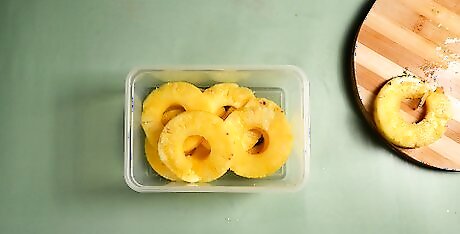
Freeze chopped pineapple for 8 to 12 months. Take a fresh, ripe pineapple and slice it up however you desire (sticks, wedges, etc.). Transfer the cut fruit to freezer-safe bags or freezer-safe containers, leaving a small amount of space between the fruit and the seal. As a general rule of thumb, frozen fruit is freshest when eaten within 8-12 months of freezing. Mark the date on your bag or container so you don’t forget when you first stashed it there.
How to Can Pineapple
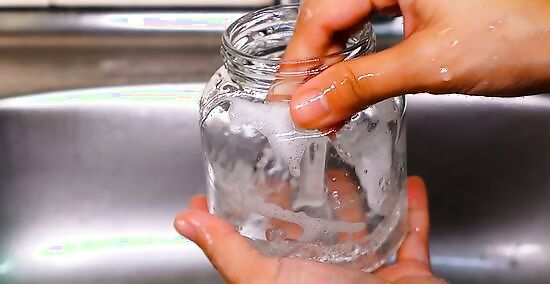
Wash the canning jars and lids with soap and water. Clean the canning jars, lids, and sealing rings by hand with dish soap and hot water, or run them through a dishwasher cycle. Rinse the jars thoroughly with hot water, or use a separate sanitizing rinse cycle in your dishwasher to remove any soap residue. Proceed to the next step while the jars and lids are still hot.
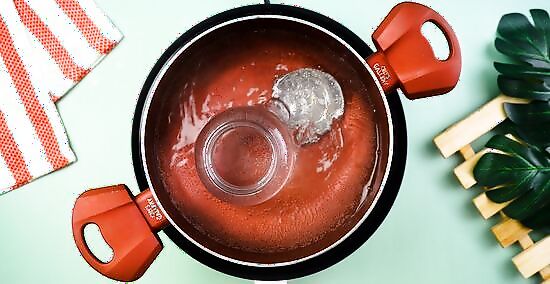
Sterilize the clean jars and lids in boiling water. Place a canning rack or a kitchen towel in the bottom of a stock pot that’s big enough to hold all the jars and lids. Set the jars right-side up in the pot and nestle the lids and sealing rings in between them. Fill the insides of the jars followed by the whole pot with water until it covers the tops of the jars by at least 1 in (2.5 cm). Put the pot on high heat and bring the water to a boil. Boil the jars and lids for 10 minutes if you’re near sea level, and for 1 additional minute for each 1,000 ft (300 m) you are above sea level. For example, if you live in Miami, boil the jars for 10 minutes. If you live in Denver, give them 15 minutes. Use metal canning tongs to carefully empty and remove the jars and lids, then place them on a clean towel. Move on to the next step while the jars are still hot. Reduce the heat to low so the water in the pot remains hot.
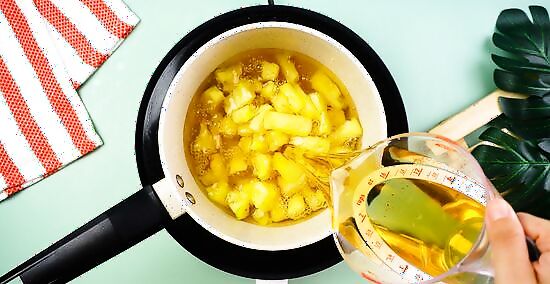
Simmer the cut pineapple pieces in apple juice for 10 minutes. Add the cut pineapple to a saucepan and add enough apple juice to allow the pieces to float and circulate freely. Turn the heat to medium-high until the juice begins to bubble, then turn it to medium-low or low to maintain a simmer for 10 minutes. You can start this step while your jars and lids are sterilizing, rather than waiting until the jars are ready to pull from the boiling water. Proceed to the next step while both the pineapple and the jars are still hot. White grape juice and canning syrup also work here.
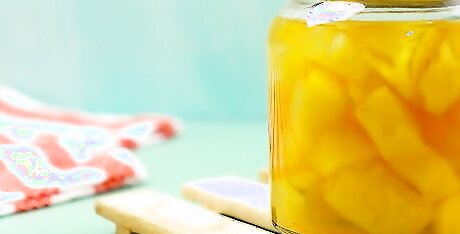
Fill and seal the jars, leaving a little space at the top. Place a canning funnel on top of a jar and use a slotted spoon to add hot pineapple pieces to the jar until it’s about 2/3 of the way full. Use a ladle to add the hot juice or syrup until the jar is full to within ⁄2–1 in (1.3–2.5 cm) of the top. This air gap is known as the “headspace” within the canning jar and is essential to the process. Seal the jars using the canning lids and rings. Fill the other jars in the same manner. Always leave at least ⁄2 in (1.3 cm) of headspace in each jar.
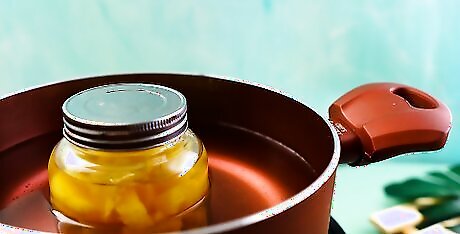
Return the jars to the pot of hot water and add water if needed. Use the canning tongs to lift each jar securely by its neck and slowly lower it into place, either on the canning rack or the towel at the bottom of the pot. Repeat with the other jars. Add more water to the pot if the jars are not covered by at least 1 in (2.5 cm) of water. Ideally, make sure there’s at least 1 in (2.5 cm) of space between the water level and the top rim of the pot. Otherwise, water may bubble over when the pot is boiling vigorously.
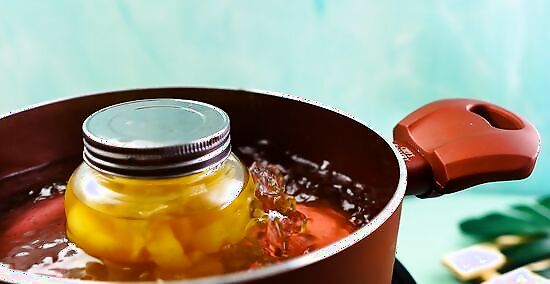
Bring the water to a rapid boil for 15-35 minutes, as required for safety. Turn the heat to high and watch for the water to come to a full, rolling boil. Start a timer at this point and boil the filled jars for the amount of time listed below: 1 pint or 16 fl oz (470 ml) jars: 15 minutes at 0–1,000 ft (0–305 m) above sea level; 20 minutes at 1,000–6,000 ft (300–1,830 m); 25 minutes at above 6,000 ft (1,800 m). 1 quart or 32 fl oz (950 ml) jars: 20 minutes at 0–1,000 ft (0–305 m) above sea level; 25 minutes at 1,000–3,000 ft (300–910 m); 30 minutes at 3,000–6,000 ft (910–1,830 m); 35 minutes at above 6,000 ft (1,800 m).
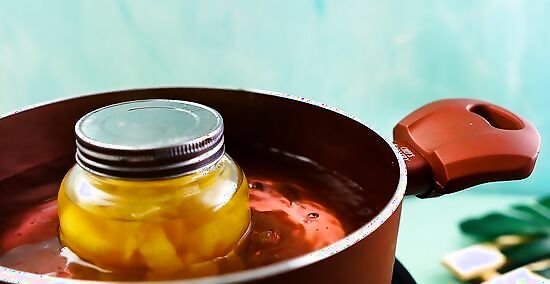
Shut off the heat, wait 5 minutes, and carefully remove the jars. After waiting 5 minutes to let the contents of the jars settle to the bottom, use your canning tongs to pull the jars from the water one at a time. Place the jars on a clean towel or a cooling rack.
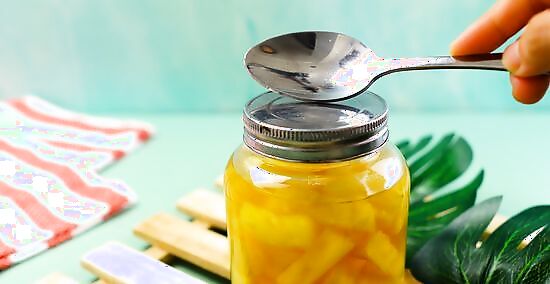
Check that the lids are sealed properly after 12-24 hours of cooling. Unscrew the sealing rings and check that each lid is sealed by: Pressing on the center of the lid—if it pops back up, the jar isn’t sealed Tapping on the lid with a metal spoon—a dull sound indicates a bad seal Looking across the lid’s top at eye level—if the lid doesn’t have a slight downward (concave) indentation, it’s not sealed properly
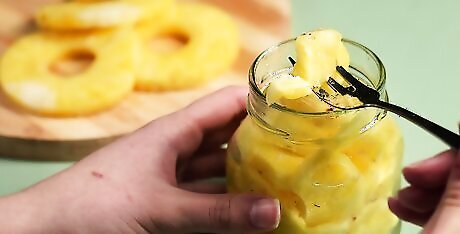
Eat, refrigerate, freeze, or re-can any fruit that isn’t properly sealed. If any jars don’t seal properly, do not try to store them long-term at room temperature. Instead, do one of the following: Eat the pineapple inside the jar right away. Refrigerate the jar and eat the pineapple within 3 days. Pour the pineapple into a freezer-safe container and freeze it for up to 3 months. Repeat the canning process immediately. Discard the pineapple.
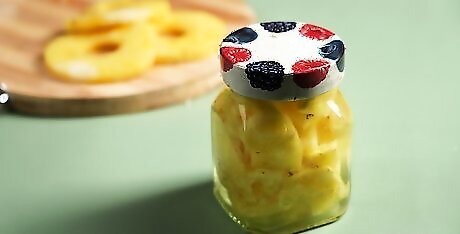
Store your pineapple in a cool, dry area and enjoy it within 18 months. Canned pineapple doesn’t need to be refrigerated until the container is open—at that point, stick it in the fridge and use it within 1 week. If unopened and kept in cool, dry spot, canned pineapple can stay fresh for around 18 months. Don’t eat from any leaking or dented containers.
How to Cut Pineapple
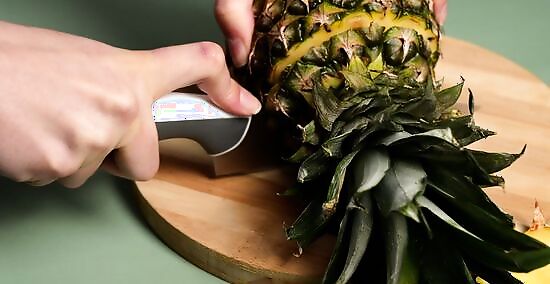
Slice off the ends. Use a sharp knife to trim off the fronds (the green part sticking out the top) and the very bottom. This leaves you with a cylinder of fruit that’s easier to work with.
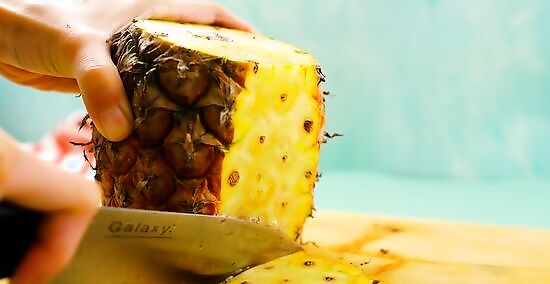
Slice off the “eyes” from the sides of the fruit. Working around the perimeter of the pineapple, slice off the bumpy rind from the fruit (without removing too much of the actual fruit). Remove any straggling pieces of rind individually or with a fruit peeler.
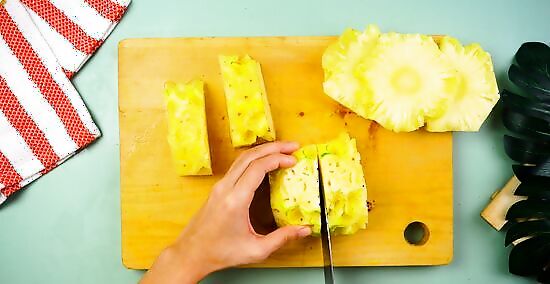
Cut the pineapple into quarters and remove the core from each piece. Slice the pineapple cylinder evenly down the middle, and then slice it again crossways. Take each quartered pineapple chunk and carve out the stiff section of the pineapple core from the tapered tip of each wedge. Alternative: Instead of quartering your pineapple, place the fruit on its side and cut it into thin slices. Then, use a pineapple corer to remove the stiff center from each ring.
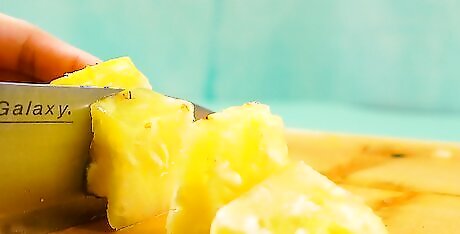
Chop up the pineapple into smaller pieces. Cut along each wedge horizontally, slicing the fruit into small, bite-sized chunks. Your pineapple is now ready to enjoy (or store)! Feel free to leave the pineapple as-is if you prefer pineapple sticks or large wedges.


















Comments
0 comment